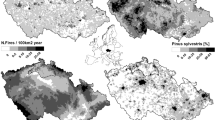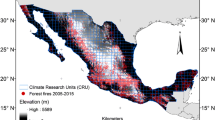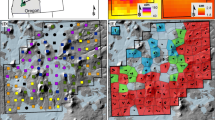Abstract
The characterization of the fire regime in the boreal forest rarely considers spatial attributes other than fire size. This study investigates the spatial attributes of fires using the physiography of the landscape as a spatial constraint at a regional scale. Using the Canadian National Fire Database, the size, shape, orientation and eccentricity were assessed for 1,136 fires between 1970 and 2010 in Quebec’s boreal forest and were summarized by ecodistrict. These spatial metrics were used to cluster 33 ecodistricts into homogeneous fire zones and then to determine which environmental variables (climate, topography, hydrography, and surficial deposits) influence the spatial attributes of fires. Analyses showed that 28 out of 33 ecodistricts belonging to a given fire zone were spatially contiguous, suggesting that factors driving the spatial attributes of fire are acting at a regional scale. Indeed, the orientation and size of fires vary significantly among the zones and are driven by the spatial orientation of the landscape and the seasonal regional climate. In some zones, prevailing winds during periods conducive to fire events parallel to the orientation of the landscape may favour the occurrence of very large fires (>100,000 ha). Conversely, an orientation of the landscape opposite to the prevailing winds may act as a natural firebreak and limit the fire size and orientation. This study highlights the need to consider the synergistic relationship between the landscape spatial patterns and the climate regime over the spatial attributes of fire at supra-regional scale. Further scale-dependant studies are needed to improve our understanding of the spatial factors controlling the spatial attributes of fire.





Similar content being viewed by others
References
Barros AM, Pereira J, Lund UJ (2012) Identifying geographical patterns of wildfire orientation: a watershed-based analysis. For Ecol Manag 264:98–107
Borcard D, Gillet F, Legendre P (2011) Numerical ecology with R. Springer, New York
Bouchard M, Pothier D, Gauthier S (2008) Fire return intervals and tree species succession in the North Shore region of eastern Quebec. Can J For Res 38:1621–1633
Boulanger Y, Gauthier S, Gray DR, Le Goff H, Lefort P, Morissette J (2013) Fire regime zonation under current and future climate over eastern Canada. Ecol Appl 23:904–923
Buliung RN, Remmel TK (2008) Open source, spatial analysis, and activity-travel behaviour research: capabilities of the aspace package. J Geogr Syst 10:191–216
Canadian Wildland Fire Information System (CWFIS) (2012). http://cwfis.cfs.nrcan.gc.ca/datamart/metadata/nfdbpoly
Clark CD, Knight JK, Gray JT (2000) Geomorphological reconstruction of the Labrador sector of the Laurentide ice sheet. Quat Sci Rev 19:1343–1366
Collins BM, Kelly NM, Wagtendonk JW, Stephens SL (2007) Spatial patterns of large natural fires in Sierra Nevada wilderness areas. Landsc Ecol 22:545–557
Cyr D, Gauthier S, Bergeron Y (2007) Scale-dependent determinants of heterogeneity in fire frequency in a coniferous boreal forest of eastern Canada. Landsc Ecol 22:1325–1339
Ecological Stratification Working Group (ESWG) (1995) A national ecological framework for Canada. Agriculture and agric-food Canada, Research Branch, Centre for Land and Biological Resources Research and Environment Canada, State of the Environment Directorate, Ecozone Analysis Branch, Ottawa/Hull. Report and national map at 1:7,500,000 scale
Falk DA, Heyerdahl EK, Brown PM, Farris C, Fulé PZ, McKenzie D, Swetnam TW, Taylor AH, Van Horne ML (2011) Multi-scale controls of historical forest-fire regimes: new insights from fire-scar networks. Front Ecol Environ 9:446–454
Finney MA, Seli RC, McHugh CW, Ager AA, Bahro B, Agee JK (2007) Simulation of long-term landscape-level fuel treatment effects on large wildfires. Int J Wildland Fire 16:712–727
Flannigan M, Campbell I, Wotton M, Carcaillet C, Richard P, Bergeron Y (2001) Future fire in Canada’s boreal forest: paleoecology results and general circulation model-regional climate model simulations. Can J For Res 31:854–864
Flatley WT, Lafon CW, Grissino-Mayer HD (2011) Climatic and topographic controls on patterns of fire in the southern and central Appalachian Mountains, USA. Landsc Ecol 26:195–209
Gauthier S, Chabot M, Drolet B, Plante C, Coupal J, Boivin C, Juneau B, Lefebvre F, Ménard B, Villeneuve R, Gagnon L (2005) Groupe de travail sur les objectifs opérationnels de la SOPFEU: Rapport d’analyse. SOPFEU internal report. (Québec)
Girardin MP, Tardif J, Flannigan MD, Wotton BM, Bergeron Y (2004) Trends and periodicities in the Canadian drought code and their relationships with atmospheric circulation for the southern Canadian boreal forest. Can J For Res 34:103–119
Hellberg E, Niklasson M, Granström A (2004) Influence of landscape structure on patterns of forest fires in boreal forest landscapes in Sweden. Can J For Res 34:332–338
Heyerdahl EK, Brubaker LB, Agee JK (2001) Spatial controls of historical fire regimes: a multiscale example from the Interior West, USA. Ecology 82:660–678
Hirsch K, Kafka V, Tymstra C, McAlpine R, Hawkes B, Stegehuis H, Quintilio S, Gauthier S, Peck K (2001) Fire-smart forest management: a pragmatic approach to sustainable forest management in fire-dominated ecosystems. For Chron 77:357–363
Jansson KN, Kleman J, Marchant DR (2002) The succession of ice-flow patterns in north-central Québec-Labrador, Canada. Quat Sci Rev 21:503–523
Jenkins MJ, Page WG, Hebertson EG, Alexander ME (2012) Fuels and fire behavior dynamics in bark beetle-attacked forests in Western North America and implications for fire management. For Ecol Manag 275:23–34
Jenness J (2005) Distance/Azimuth Tools v.1.6 extension for ArcView 3x, v38a. (Jenness Enterprises). http://www.jennessent.com/
Kellogg LKB, McKenzie D, Peterson DL, Hessl AE (2008) Spatial models for inferring topographic controls on historical low-severity fire in the eastern Cascade Range of Washington, USA. Landsc Ecol 23:227–240
Krebs P, Pezzatti GB, Mazzoleni S, Talbot LM, Conedera M (2010) Fire regime: history and definition of a key concept in disturbance ecology. Theory Biosci 129:53–69
Legendre P, Gallagher ED (2001) Ecologically meaningful transformations for ordination of species data. Oecologia 129:271–280
Linn R, Winterkamp J, Edminster C, Colman JJ, Smith WS (2007) Coupled influences of topography and wind on wildland fire behaviour. Int J Wildland Fire 16:183–195
Madoui A, Leduc A, Gauthier S, Bergeron Y (2010) Spatial pattern analyses of post-fire residual stands in the black spruce boreal forest of western Quebec. Int J Wildland Fire 19:1110–1126
Mansuy N, Gauthier S, Robitaille A, Bergeron Y (2010) The effects of surficial deposit–drainage combinations on spatial variations of fire cycles in the boreal forest of eastern Canada. Int J Wildland Fire 19:1083–1098
Mansuy N, Gauthier S, Robitaille A, Bergeron Y (2012) Regional patterns of postfire canopy recovery in the northern boreal forest of Quebec: interactions between surficial deposit, climate, and fire cycle. Can J For Res 42:1328–1343
McKenzie D, Kennedy MC (2012) Power laws reveal phase transitions in landscape controls of fire regimes. Nat Commun 3:726
McKenzie D, Miller C, Falk DA (2011) Toward a theory of landscape fire. In The landscape ecology of fire. Ecol Stud 213:3–25
Mermoz M, Kitzberger T, Veblen TT (2005) Landscape influences on occurrence and spread of wildfires in Patagonian forests and shrublands. Ecology 86:2705–2715
Ministère des Ressources naturelles du Québec (MRNQ) (2013). http://www.mrn.gouv.qc.ca/forets/fimaq/feu/fimaq-feu.jsp
Natural Resources Canada (NRCan) (2012). http://geogratis.cgdi.gc.ca/clf/en
Oksanen JF, Blanchet G, Kindt R, Legendre P, O’Hara B, Stevens MHH, Oksanen MJ, Suggests MASS (2013) Vegan: community ecology package. R package version 2.0-8. http://CRAN.R-project.org/package=vegan
Parisien MA, Moritz MA (2009) Environmental controls on the distribution of wildfire at multiple spatial scales. Ecol Monogr 79:127–154
Parisien MA, Sirois L (2003) Distribution and dynamics of tree species across a fire frequency gradient in the James Bay region of Quebec. Can J For Res 33:243–256
Parisien MA, Peters VS, Wang Y, Little JM, Bosch EM, Stocks BJ (2006) Spatial patterns of forest fires in Canada, 1980–1999. Int J Wildland Fire 15:361–374
Parisien MA, Miller C, Ager AA, Finney MA, (2010) Use of artificial landscapes to isolate controls on burn probability. Landsc Ecol 25:79–93
Parisien MA, Parks SA, Krawchuk MA, Little JM, Flannigan MD, Gowman LM, Moritz MA (2014) An analysis of controls on fire activity in boreal Canada: comparing models built with different temporal resolutions. Ecol Appl. doi:10.1890/13-1477.1
Parks SA, Parisien MA, Miller C (2012) Spatial bottom-up controls on fire likelihood vary across western North America. Ecosphere 3:12–22
Prest VK, Grant DR, Rampton VN (1967) Glacial map of Canada. Cartography by the Geological Survey of Canada, 1964–1966. [Map]/Geological Survey of Canada, Department of Energy, Mines, and Resources; 1253A
R Development Core Team (2013) R: a language and environment for statistical computing. http://www.R-project.org
Remmel TK, Perera AH (2009) Mapping natural phenomena: boreal forest fires with non-discrete boundaries. Cartographica 44:274–288
Robitaille A, Allard M (2007) Guide pratique d’identification des dépôts de surface au Québec. 2e éd. Les Publications du Québec, Québec, QC
Rowe JS, Scotter GW (1973) Fire in the boreal forest. Quat Res 3:444–464
Schoennagel T, Veblen TT, Romme WH (2004) The interaction of fire, fuels, and climate across Rocky Mountain forests. Bioscience 54:661–676
Segal M, Xiao Y (2011) Multivariate random forests. WIREs Data Mining Knowl Discov 1:80–87
Senici D, Lucas A, Chen HY, Bergeron Y, Larouche A, Brossier B, Blarquez O, Ali AA (2013) Multi-millennial fire frequency and tree abundance differ between xeric and mesic boreal forests in central Canada. J Ecol 101:356–367
Sharples JJ (2008) Review of formal methodologies for wind–slope correction of wildfire rate of spread. Int J Wildland Fire 17:179–193
Skinner WR, Stocks BJ, Martell DL, Bonsal B, Shabbar A (1999) The association between circulation anomalies in the mid-troposphere and area burned by wildland fire in Canada. Theor Appl Climatol 63:89–105
Skinner WR, Shabbar A, Flannigan MD, Logan K (2006) Large forest fires in Canada and the relationship to global sea surface temperatures. J Geophys Res 5111:D14
Trenhaile AS (1990) The geomorphology of Canada. Oxford University Press, Toronto
Van Wagner CE (1987) Development and structure of the Canadian forest fire weather index system. Forest Tech Report 35. Canadian Forest Service, Ottawa
Veillette JJ (1994) Evolution and paleohydrology of glacial lakes Barlow and Ojibway. Quat Sci Rev 13:945–971
Veillette JJ (2004) Ice-flow chronology and palimpsest, long-distance dispersal of indicator clasts, north of the St. Lawrence River Valley, Quebec. Geogr Phys Quat 58:187–216
Viegas DX (2004) Slope and wind effects on fire propagation. Int J Wildland Fire 13:143–156
Ward JH Jr (1963) Hierarchical grouping to optimize an objective function. J Am Stat Assoc 58:236–244
Wu Z, He HS, Liang Y, Cai L, Lewis BJ (2013) Determining relative contributions of vegetation and topography to burn severity from LANDSAT imagery. Environ Manag 52:821–836
Acknowledgments
This research was made possible by the financial and in-kind support provided by Quebec’s Ministère des Ressources naturelles (MRNQ). We thank Natural Resources Canada for the Canadian National Fire Database, the map of surficial deposits and the hydrography data. We are very grateful to Pamela Cheers and to Alix Rive for reviewing the manuscript and helpful comments. We are also grateful to the Université du Québec à Montréal and the Canadian Forest Service for their logistical support. We also thank NSERC, FQRNT Fonds Forestier and UQAM (excellence award) for their financial support.
Author information
Authors and Affiliations
Corresponding author
Electronic supplementary material
Below is the link to the electronic supplementary material.
Rights and permissions
About this article
Cite this article
Mansuy, N., Boulanger, Y., Terrier, A. et al. Spatial attributes of fire regime in eastern Canada: influences of regional landscape physiography and climate. Landscape Ecol 29, 1157–1170 (2014). https://doi.org/10.1007/s10980-014-0049-4
Received:
Accepted:
Published:
Issue Date:
DOI: https://doi.org/10.1007/s10980-014-0049-4




